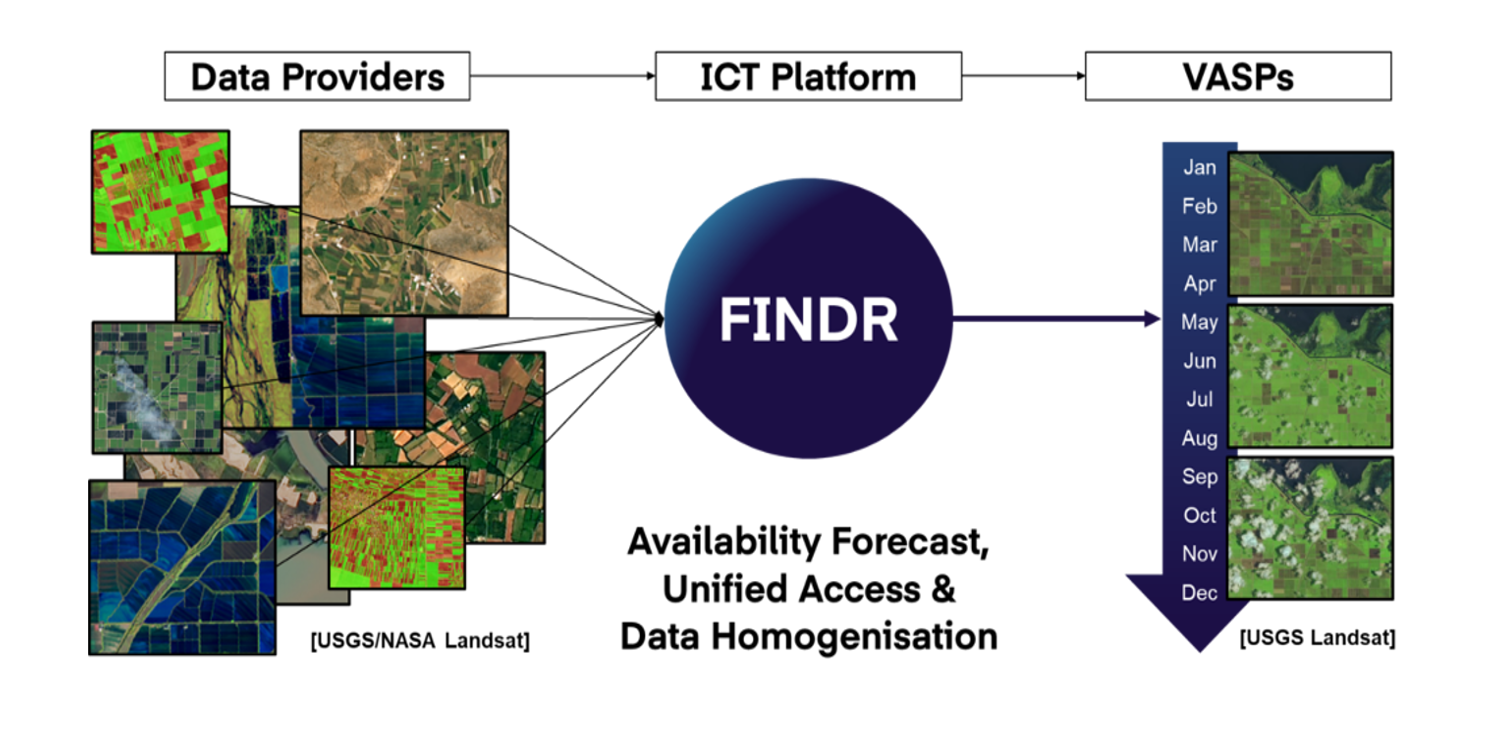
Introduction
In this project, we develop the Information and Communication Technology (ICT) platform FINDR.
It provides universal, transparent, and unified access to EO data critical for sustainable and resilient food production in the agri-food sector. FINDR offers a comprehensive and transparent overview about all available data from major EO providers to enable faster and better-informed decision-making. Furthermore, it enables accurate near-future forecasts on data availability to manage data ingestion and a homogenization approach to allow for obstacle-free integration of EO data from different providers. This will support closing coverage gaps in existing and future information products. Once implemented, FINDR will be tested on field-level together with an end user by the consortium’s VASP. A start-up ensures the commercialization and continuous development of FINDR beyond the project duration.
We expect FINDR to benefit existing applications with increased data availability, reduced maintenance and integration effort and to boost VASP uptake for EO data by reducing interfacing effort, considerably reducing entry barriers for new applications.
Background
The United Nations (UN) predict that global food consumption will increase by about 50 percent in 2050, despite water scarcity, without more arable land, and under changing climatic conditions. To prevent a global agricultural break-down in our highly interconnected world with its complex food chain, we need to address this challenge on a global scale. Our capability to do so is directly connected to our ability to monitor crop health: globally, at field level, and on time scales relevant to temporal trends. In view of a total global agricultural area of around 1.5 billion hectares, the only applicable solution is satellite-based Earth Observation (EO).
Since primary food producers (PFPs) cannot directly benefit from EO data, they heavily depend on value added service providers (VASPs) to provide satellite-based applications and services derived from EO sources. VASPs provide insight into crop health and water demands for PFP as well as support political leaders in responding to crisis, making the VASP layer vital to agriculture. However, with a growing amount of not intercompatible data and an increasing number of data providers, this becomes a progressively complex task.
Main project activities
The project’s overall objective is to provide universal, transparent, and unified access to EO data critical for sustainable and resilient food production in the agri-food sector. The following objectives will be addressed:
- Creation of a comprehensive and transparent overview of available data from all major existing EO systems enabling faster and better-informed decisions
- Provision of accurate near-future forecasts on data availability to timely react to and mitigate potential coverage gaps by use of alternative data sources
- Obstacle-free integration of EO data from different sources to spatio-temporally complement existing and future information products
- Implementation of a scalable processing infrastructure for distributed data infrastructures enhanced by caching optimization for large-scale data

Expected social impact
In view of food security, the project improves the reaction capabilities to potential threats to the agri-food supply chain. In general, we believe that EO-data-based services are a vital information source for political decision makers. The European Commissioner for Agriculture, Phil Hogan, said, “The eye in the sky is the key to the future of the Common Agricultural Policy (CAP)” [8]. Former H2020 projects like Re.CAP or Sen4CAP focused on the implementation and monitoring possibilities of the CAP. FINDR directly strengthens these initiatives at the most fundamental level, by facilitating the transition from research to applications.
Implementation and plans to reach target groups
At the beginning of the project, a dissemination, communication and exploitation plan (deliverables D2.1 and D2.2) will be created to maximise the value of the funded activity by
- clearly identifying and describing the project’s outputs, i.e. the results creating direct impact by project partners or other stakeholders,
- circulation of results or knowledge exposure targeting potential stakeholders, i.e. dissemination, and
- further informing and preparing utilisation strategies of project results by partners or other stakeholders after the project, i.e. exploitation.
The following table lists expected project results and benefitting target audiences labelled as:
- Project partners
- The research communities
- Industry and innovators (including VASP)
- Civil society & member states

In advance, a startup has been spun out, the ConstellR GmbH, to ensure the impact beyond the project’s duration and to drive the commercialization. The current development status will be accessible via the project’s website and supported by our LinkedIn and Twitter channels. FINDR will be part of two technology transfer platforms with webinars and massive open online courses that are currently under development.
Consortium

Figure 1: FINDRs project partners at work: Some of the participants of FINDRs Kick-of-Meeting
Coordinated by:
- Jonah Vincke - Fraunhofer Institute for High-Speed Dynamics, Ernst-Mach-Institut, EMI, Germany,
Partners:
- Daniel Spengler and Daniel Scheffler - Helmholtz Center Potsdam German Research Center for Geosciences, Germany
- Henk Pelgrum - eLEAF (ELE), the Netherlands
- Lukasz Dutka - ACK Cyfronet AGH, Poland
Funded by:
- Bundesministerium für Bildung und Forschung, Germany
- Ministry of Agriculture, Nature and Food Quality, the Netherlands
- National Centre for Research and Development, Poland
News articles
Video
Introduction
In this project, we develop the Information and Communication Technology (ICT) platform FINDR.
It provides universal, transparent, and unified access to EO data critical for sustainable and resilient food production in the agri-food sector. FINDR offers a comprehensive and transparent overview about all available data from major EO providers to enable faster and better-informed decision-making. Furthermore, it enables accurate near-future forecasts on data availability to manage data ingestion and a homogenization approach to allow for obstacle-free integration of EO data from different providers. This will support closing coverage gaps in existing and future information products. Once implemented, FINDR will be tested on field-level together with an end user by the consortium’s VASP. A start-up ensures the commercialization and continuous development of FINDR beyond the project duration.
We expect FINDR to benefit existing applications with increased data availability, reduced maintenance and integration effort and to boost VASP uptake for EO data by reducing interfacing effort, considerably reducing entry barriers for new applications.
Background
The United Nations (UN) predict that global food consumption will increase by about 50 percent in 2050, despite water scarcity, without more arable land, and under changing climatic conditions. To prevent a global agricultural break-down in our highly interconnected world with its complex food chain, we need to address this challenge on a global scale. Our capability to do so is directly connected to our ability to monitor crop health: globally, at field level, and on time scales relevant to temporal trends. In view of a total global agricultural area of around 1.5 billion hectares, the only applicable solution is satellite-based Earth Observation (EO).
Since primary food producers (PFPs) cannot directly benefit from EO data, they heavily depend on value added service providers (VASPs) to provide satellite-based applications and services derived from EO sources. VASPs provide insight into crop health and water demands for PFP as well as support political leaders in responding to crisis, making the VASP layer vital to agriculture. However, with a growing amount of not intercompatible data and an increasing number of data providers, this becomes a progressively complex task.
Main project activities
The project’s overall objective is to provide universal, transparent, and unified access to EO data critical for sustainable and resilient food production in the agri-food sector. The following objectives will be addressed:
Expected social impact
In view of food security, the project improves the reaction capabilities to potential threats to the agri-food supply chain. In general, we believe that EO-data-based services are a vital information source for political decision makers. The European Commissioner for Agriculture, Phil Hogan, said, “The eye in the sky is the key to the future of the Common Agricultural Policy (CAP)” [8]. Former H2020 projects like Re.CAP or Sen4CAP focused on the implementation and monitoring possibilities of the CAP. FINDR directly strengthens these initiatives at the most fundamental level, by facilitating the transition from research to applications.
Implementation and plans to reach target groups
At the beginning of the project, a dissemination, communication and exploitation plan (deliverables D2.1 and D2.2) will be created to maximise the value of the funded activity by
The following table lists expected project results and benefitting target audiences labelled as:
In advance, a startup has been spun out, the ConstellR GmbH, to ensure the impact beyond the project’s duration and to drive the commercialization. The current development status will be accessible via the project’s website and supported by our LinkedIn and Twitter channels. FINDR will be part of two technology transfer platforms with webinars and massive open online courses that are currently under development.
Consortium
Figure 1: FINDRs project partners at work: Some of the participants of FINDRs Kick-of-Meeting
Coordinated by:
Partners:
Funded by:
News articles
Video